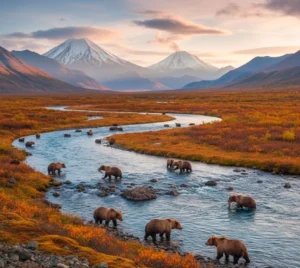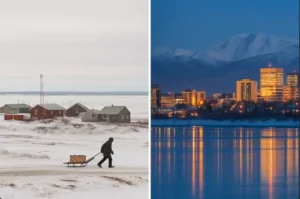Alaska tourism industry has always been vital to its economy, drawing visitors worldwide to experience its breathtaking landscapes, rich wildlife, and unique cultural heritage. As we move into 2024, the industry is undergoing significant changes that will shape how people travel to and explore the state.
These changes are driven by various factors, including technological advances, shifting visitor demographics, and a growing emphasis on sustainable tourism. In this post, we’ll examine the biggest changes in Alaska’s tourism industry for 2024 and what they mean for both travelers and the local economy.

Overview of Alaska’s Tourism Boom
Alaska’s tourism sector has experienced a strong recovery and growth, particularly in the cruise industry. In 2022, approximately 2.7 million visitors traveled to Alaska, staying an average of 8.5 nights.
The cruise industry played a significant role in this resurgence, with a record 1.65 million cruise passengers visiting in 2023, accounting for about 60% of summer visitors. While specific projections for 2024 are still being finalized, early indicators point to continued strong demand, especially in the cruise sector.
| Year | Cruise Passenger Numbers |
| 2022 | 1.3 million |
| 2023 | 1.65 million |
| 2024 | Projected 1.64 million |
Economically, the tourism industry had a substantial impact, contributing around $5.6 billion to Alaska’s economy in 2022, with $3.9 billion from direct consumer spending. Visitor spending, excluding travel fares, totaled nearly $2.2 billion annually.
When labor income from tourism-related jobs is included, this figure rises to $3.7 billion, resulting in a total economic output of about $4.5 billion. The sector also supported approximately 56,711 jobs in 2022, highlighting its importance to the state’s economy.
Regionally, Southeast Alaska, a key tourism area, saw a significant rebound as cruise tourists began to explore other parts of the state. COVID-19 heavily impacted this region but has shown robust recovery, with cruise tourist numbers expected to reach pre-pandemic levels of around 1.3 million in 2023.
Alaska’s cruise industry is anticipated to grow, with strong bookings for upcoming seasons. The Alaska Travel Industry Association (ATIA) expects the momentum from 2023 to carry into 2024, further boosting the state’s tourism sector.
Independent Travelers Versus Cruise Passengers Demographics
| Year | Percentage of Independent Travelers | Percentage of Cruise Passengers | Total Visitors |
| 2021 | 20% | 80% | 124,600 |
| 2022 | 30% | 75% | 2.7 million |
| 2023 | 35% | 65% | 1.65 million |
| 2024 | 40% (Projected) | 60% (Projected) | 2.66 million |
Most Significant Changes in Alaska’s Tourism Industry for 2024
Alaska’s tourism industry is expected to gear up for another strong year in 2024, with several exciting developments on the horizon:
1. Cruise Passenger Projections
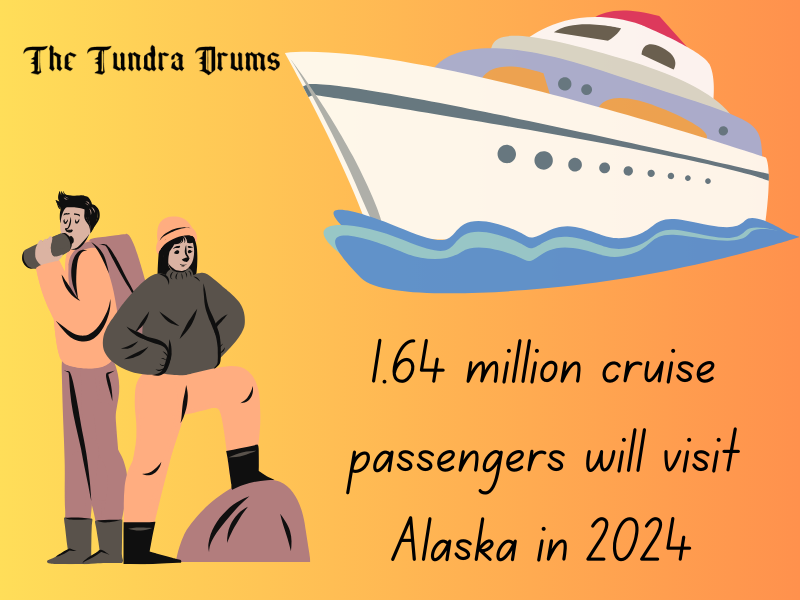
Alaska’s Cruise Surge Continues: The Cruise Lines International Association projects that around 1.64 million cruise passengers will visit Alaska in 2024. This steady influx underscores Alaska’s enduring appeal as a prime cruise destination.
2. Economic Impact
Tourism’s Mighty Contribution: The Alaska Travel Industry Association (ATIA) anticipates the tourism sector will maintain its impressive economic impact in 2024, mirroring the $5.6 billion contribution seen in 2022. Tourism continues to be a cornerstone of Alaska’s economy.
3. Visitor Composition
Rising Tide of Independent Travelers: Independent travelers will comprise about 35% of the summer tourism market in 2024. The ATIA is sharpening its focus on this segment, seeking to expand it even further.
4. Winter Tourism Growth
Winter Wonderland Growth: Winter tourism in Alaska is on the rise, with independent travelers accounting for 100% of visitors during this season. The ATIA is particularly optimistic about winter tourism, which has grown faster than summer visits in recent years.
5. Marketing and Promotion
Year-Round Appeal: The ATIA invests heavily in year-round travel promotion to keep the momentum going. Strategic media campaigns are designed to maximize returns and attract visitors throughout the year, ensuring Alaska remains a top destination no matter the season.
These trends highlight Alaska’s continued growth as a top destination. Both summer and winter tourism are poised for significant expansion in 2024. Keep an eye on these developments as they shape the future of Alaska’s vibrant tourism industry.
Impact of Technology on the Tourism Experience in Alaska
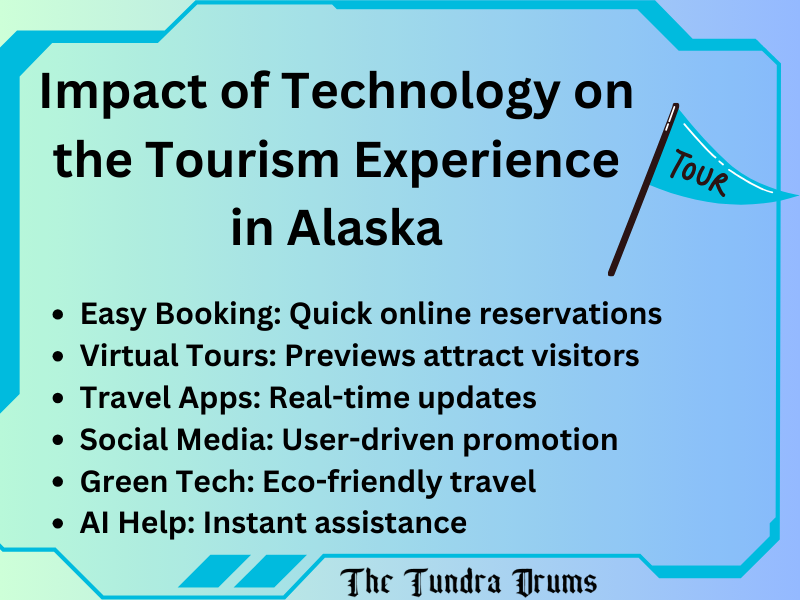
Technology has significantly transformed the tourism experience in Alaska, enhancing how visitors plan, book, and enjoy their trips. Here are key ways technology is impacting the tourism experience:
1. Digital Booking and Planning:
Online booking platforms and travel apps have simplified planning a trip to Alaska. Tourists can now easily book flights, accommodations, and tours online, compare prices, and read reviews, all of which help them make informed decisions. This ease of access has contributed to an increase in independent travelers who prefer to customize their itineraries.
2. Virtual and Augmented Reality (VR/AR):
VR and AR are increasingly used to offer immersive experiences, allowing potential visitors to explore Alaska’s attractions virtually before they even set foot in the state. This technology helps market Alaska’s remote and unique destinations, giving tourists a preview of what to expect, which can drive bookings and visits.
3. Mobile Apps for Real-Time Information:
Mobile apps provide real-time updates on weather conditions, wildlife sightings, and local events, which are crucial for travelers in Alaska due to the state’s vast and often remote landscapes. These apps also offer navigation assistance, trail maps, and emergency contacts, enhancing the safety and convenience of travel.
4. Social Media and User-Generated Content:
Social media platforms like Instagram, Facebook, and YouTube influence travel decisions. Tourists share their experiences online, promoting Alaska as a destination and providing valuable insights for future travelers. This user-generated content is a powerful marketing tool, driving interest and tourism to the state.
5. Sustainable Travel Technology:
With growing awareness of environmental impacts, technology is being used to promote sustainable tourism in Alaska. Innovations such as eco-friendly transportation options and the ability to track travel plans’ carbon footprints are helping to reduce the environmental impact of tourism in the state.
6. AI and Chatbots:
Artificial intelligence (AI) and chatbots improve customer service globally, including in Alaska’s tourism sector. These technologies provide instant responses to tourist inquiries, assist in itinerary planning, and offer personalized recommendations. It enhances the overall visitor experience.
Growth in Adventure and Experience-Based Tourism in Alaska
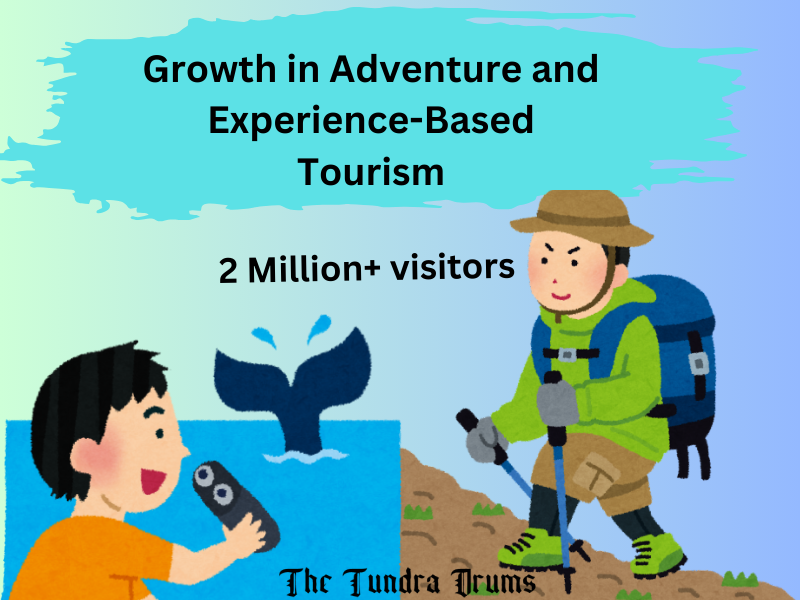
Market Trends
- Rising Interest: Adventure tourism proliferates in Alaska, with activities like hiking, kayaking, whale watching, and wildlife viewing becoming increasingly popular.
- Global Shift: This trend reflects a broader international movement towards experiential travel, where tourists seek unique, immersive experiences.
Visitor Statistics
- Annual Visitors: Alaska welcomes over 2 million visitors annually, significantly impacting the local economy. This influx of tourists is more than double the state’s population, underscoring tourism’s role as a significant income source.
Sustainable Tourism Initiatives
- Adventure Green Alaska: This program encourages eco-friendly tourism practices among certified businesses, promoting sustainability within the industry.
- Marketing Benefits: Businesses certified by Adventure Green Alaska gain increased visibility and marketing support, which helps attract environmentally conscious travelers.
Final Verdict
Alaska’s tourism industry is expected to keep growing in 2024. Thanks to new technology, a focus on eco-friendly travel, and more interest in adventure tourism. These changes are making it easier and more exciting for visitors to explore the state, keeping Alaska a top choice for both summer and winter trips. With more visitors and a strong impact on the economy, Alaska’s tourism is set for a bright future.








